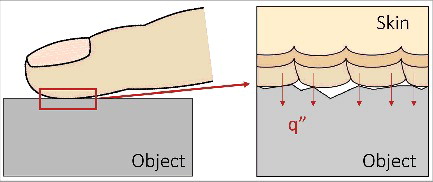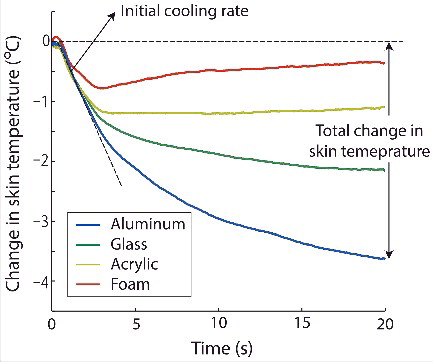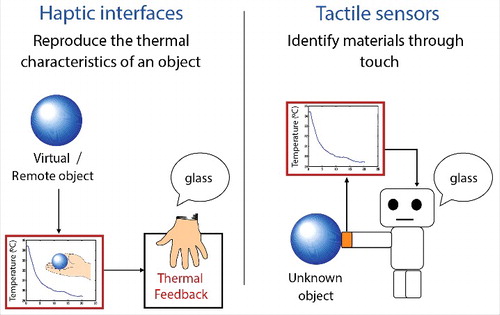Figures & data
Figure 1. Physical, perceptual, and cognitive processes involved in material recognition based on thermal cues. In the physical process, the thermal interaction between the skin and the object elicits change in skin temperature, which is a function of the object's material composition. In the perceptual process, the change in skin temperature activates thermoreceptors and the coldness perceived is used as a cue for material recognition. In the cognitive process, the perceived coldness is classified into a certain material category to reach a material judgment.

Table 1. Thermal properties of the skin and four common materials.
Figure 2. Heat transfer across skin-object interface during contact. When the skin and the object are brought into contact, only a small fraction of their surface areas is actually in contact because of the nonflatness and roughness of the contacting surfaces. This limited contact area restricts the amount of heat that can be transferred across the interface, and the degree of restriction is defined by thermal contact resistance.

Figure 3. Changes in skin temperature when touching 4 common materials: Aluminum, glass, acrylic, and foam for 20 s. These cooling curves typically take a similar form, with a rapid temperature drop at the moment of contact and a slower change as time passes. Materials with high contact coefficients, such as metal, generally elicit a higher initial cooling rate and a larger total change in skin temperature than those with low ones. For materials with low contact coefficients, such as foam (red line), the skin temperature tends to start to increase again slowly after it has reached its lowest level, resulting in a V-shaped temporal profile.

Figure 4. Temperature responses when touching 4 common materials predicted by (A) the semi-infinite body model and (B) the revised model. The semi-infinite boy model predicts the surface temperatures of the skin and object would change instantaneously to a contact temperature at the moment of contact and maintain constant throughout the contact duration (green dots and green dashed lines). The revised model takes into account the thermal contact resistance at the skin-object interface and provides a more realistic prediction on the skin (red line) and object surface (blue line) temperature responses.

Figure 5. Two major applications for material recognition based on thermal cues. In haptic interface applications, the thermal characteristics of a virtual or a remote object can be reproduced by presenting thermal feedback generated based on the pre-recorded or predicted changes in skin temperature associated with touching the object. In tactile sensor applications, the material composition of an unknown object can be ascertained by analyzing the temperature changes of the sensory body, which are elicited by the heat transfer during the contact between the tactile sensor and the object.

